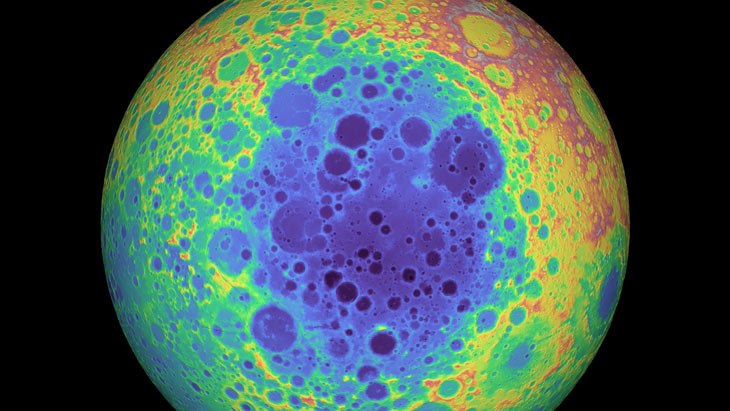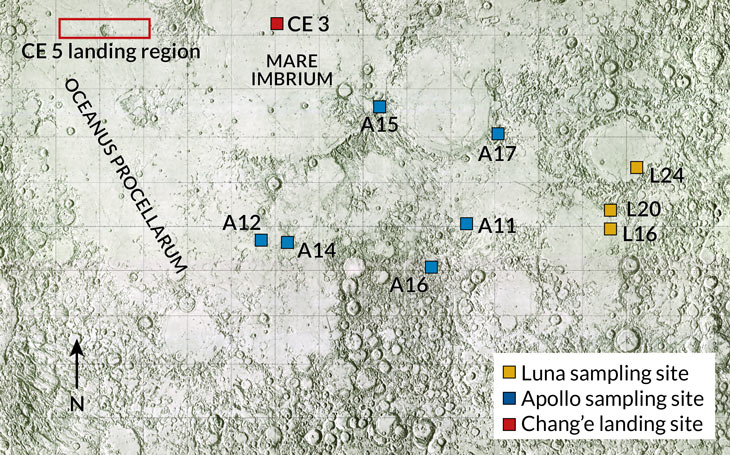China is about to visit uncharted territory on the moon
One Chinese mission will bring back the first lunar rock samples in more than four decades

HELLO FROM THE OTHER SIDE The farside of the moon, shown in this picture from NASA’s Lunar Reconnaissance Orbiter, is due to get its first robotic visitor soon. China’s Chang’e-4 spacecraft will launch for the region in December.
Goddard Space Flight Center/NASA, Arizona State University
- More than 2 years ago
China is about to make space history. In December, the country will launch the first spacecraft ever to land on the farside of the moon. Another craft, slated for takeoff in 2019, will be the first to bring lunar rocks back to Earth since 1976.
These two missions — the latest in China’s lunar exploration series named after the Chinese moon goddess, Chang’e — are at the forefront of renewed interest in exploring our nearest celestial body. India’s space agency as well as private companies based in Israel and Germany are also hoping for robotic lunar missions in 2019. And the United States aims to have astronauts orbiting the moon starting in 2023 and to land astronauts on the lunar surface in the late 2020s.
The time is ripe for new lunar exploration. Despite decades of study, Earth’s only natural satellite still contains mysteries about its formation as well as clues to the history of the solar system (SN: 4/15/17, p. 18). “There are too many things we don’t know,” says planetary scientist Long Xiao of China University of Geosciences in Wuhan. He is a coauthor of two studies published in June and July in the Journal of Geophysical Research: Planets describing the landing sites of the new Chinese missions, Chang’e-4 and -5.
To figure out what secrets the moon may still be hiding, scientists are excited to get their hands on new rock samples. The Chang’e-5 sample return mission “no doubt will have additional rock types that we haven’t sampled yet,” says planetary scientist David Blewett of Johns Hopkins University Applied Physics Laboratory in Laurel, Md. “If you came to the Earth and landed in Great Britain and made all your conclusions about the Earth from what you saw … you really wouldn’t have the whole picture.”
Journey to the dark side
The Chang’e-4 spacecraft includes a lander and a rover that were originally built as backups for the 2013 Chang’e-3 mission, which marked China’s first moon landing — and the first moon landing at all since the 1970s (SN Online: 12/16/13). The uncrewed Chang’e-3 lander-rover duo touched down in a vast lava plain in the north known as Mare Imbrium, where the craft measured the composition and thickness of the lunar soil and discovered what might be a new type of basalt, or lava-based rock.
This time, China has its sights set on lunar regions never before explored. Chang’e-4 is aiming for the moon’s largest, deepest and possibly oldest known feature created by an impact, the South Pole–Aitken basin, on the lunar farside, which always faces away from Earth. The whole basin, which is 2,500 kilometers wide and up to 8.2 kilometers deep, is too big for the rover to explore. So Chang’e-4 is shooting for the 186-kilometer-wide Von Kármán crater within the larger basin for a cosmic hole in one.

“There’s a big argument about the composition of the lunar mantle,” Xiao says. For instance, is the mantle “wet” and full of hydrated minerals, or dry? If it is wet, how did water survive the colossal impact thought to have formed the moon? Chang’e-4 won’t solve those mysteries, but its measurements can help calibrate future remote observations.
Three cameras, an infrared spectrometer and two ground penetrating radars, like those used in the Chang’e-3 mission, will help the spacecraft conduct its investigation of Von Kármán crater. Chang’e-4 also carries some newer tech: a Swedish instrument to study how charged particles from the sun interact with the lunar surface; a German instrument to gauge radiation levels, which could be important for future astronauts; and a container with seeds and insect eggs to test whether plants and insects, if they hatch, can grow together on the moon.
Because the moon always shows the same face to Earth, astronomers on the ground won’t be able to communicate directly with Chang’e-4. So in May, the Chinese space agency launched a transmission relay satellite to a point beyond the moon to bounce data and communication signals back and forth between the lunar surface and Earth (SN Online: 5/20/18). That satellite, called Queqiao, is named after the mythical bridge of magpies that spans the Milky Way once a year to enable a tryst between two lovers.
Delving into geologic history
Sometime in 2019, the Chang’e-5 craft will visit a region on the near side of the moon that no spacecraft or astronaut has been to before. And that mission will give scientists something they haven’t had in more than four decades — new lunar rock samples.
So far, scientists have studied rocks from lava fields formed early in the moon’s history, about 3.5 billion years ago. Those were brought to Earth by the U.S. Apollo missions, which ended in 1972, and the Soviet Luna missions, ending in 1976. Together, those missions brought back more than 380 kilograms of moon material.
Chang’e-5’s lander will scoop surface rocks and dig two meters deep in a 58,000-square-kilometer area called the Rümker region that’s strewn with minerals dating to a variety of periods of volcanic activity. The craft will then bundle up to two kilograms of material into a rocket, which will launch to meet Chang’e-5’s orbiter and return to Earth.
Marking the spot
Moon rocks brought back by the Soviet Union’s Luna missions (yellow) and NASA’s Apollo missions (blue) in the 1960s and ’70s all came from ancient lava flows mostly clustered around the moon’s equator. In 2013, China’s Chang’e-3 (red square) landed in a different zone of old flows farther north, but brought back no samples. The Chang’e-5 mission will return volcanic rocks from an area that has never been sampled before (outlined in red).

Studying samples from this region could reveal if the moon has been geologically active more recently than previously thought. “According to the study of Apollo samples, people think the moon was dead” for the last 3 billion years, Xiao says. But observations from previous orbiters suggest that Rümker includes basalt from lava flows that are less than 1.4 billion years old. “If the young mare basalt were confirmed, we would rewrite the heat history of the moon” — in other words, when the moon’s hot liquid rock cooled and hardened (SN: 8/5/17, p. 7).
Understanding the moon’s volcanic history could shed light on competing ideas about how the moon came to be. For instance, scientists still don’t agree on whether our neighbor formed from one giant impact with Earth in the early days of the solar system, around 4.5 billion years ago, or from about 20 small ones, or something else. Finding evidence for more recent geologic activity could be a ding for the single impact hypothesis.
What’s more, the returned samples would also be stored and preserved “so that future scientists who aren’t born yet can answer future questions we haven’t asked yet, with tools we haven’t invented yet,” says astrochemist Jamie Elsila of NASA’s Goddard Space Flight Center in Greenbelt, Md. She would know: Born nearly two years after the last Apollo mission, Elsila published a study in 2016 that used modern techniques to show that Apollo soil samples contain amino acids mostly derived from Earth.
Tricky access to new moon rocks
The prospect of studying those new rocks has excited NASA researchers and other scientists. Sample return is “the gift that keeps on giving,” says former Apollo astronaut Harrison “Jack” Schmitt, the only geologist to walk on the moon. “All of my colleagues who work directly with the samples certainly would like to get their hands on [those new rocks].”
But U.S. scientists face roadblocks to studying the new samples, thanks to the Wolf Amendment, a 2011 federal budget clause that requires congressional approval before U.S. scientists can collaborate with China or any Chinese-owned company.
“In terms of space science, I think with the Wolf Amendment, the United States took very careful aim and shot ourselves in the foot,” says space policy analyst Joan Johnson-Freese of the U.S. Naval War College in Newport, R.I. “We’ve made it very difficult for American scientists to work with otherwise unobtainable data.”
Difficult, but not impossible. American scientists could join scientists from other countries who can work directly with China, using their colleagues as a sort of go-between. The United States could also trade Apollo samples for Chang’e-5 samples, says space policy analyst Scott Pace, the executive secretary of the U.S. National Space Council.
“I think the U.S. and Russia would certainly be open to being part of a sample exchange process,” Pace says. “From a purely science standpoint, we’d love to have that. Whether the politics allows it, we’ll have to see.”
From China, Xiao agrees that collaboration is essential to understanding the moon’s history. “We don’t want this kind of thing to badly impact the science.”







